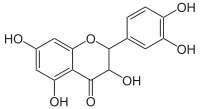- Taxifolin
-
Taxifolin  (2R,3R)-2-(3,4-dihydroxyphenyl)-3,5,7-trihydroxy-2, 3-dihydrochromen-4-oneOther namesDihydroquercetin
(2R,3R)-2-(3,4-dihydroxyphenyl)-3,5,7-trihydroxy-2, 3-dihydrochromen-4-oneOther namesDihydroquercetin
Taxifoliol
Distylin
Catechin hydrate
(+)-Taxifolin
trans-Dihydroquercetin
(+)-Dihydroquercetin
Dihydroquercetin hydrateIdentifiers CAS number 480-18-2 
PubChem 439533 ChEMBL CHEMBL66 
Jmol-3D images Image 1 - C1=CC(=C(C=C1C2C(C(=O)C3=C(C=C(C=C3O2)O)O)O)O)O
Properties Molecular formula C15H12O7 Molar mass 304.25 g/mol Exact mass 304.058303 u  (verify) (what is:
(verify) (what is:  /
/ ?)
?)
Except where noted otherwise, data are given for materials in their standard state (at 25 °C, 100 kPa)Infobox references Taxifolin is a flavanonol, a type of flavonoid. It can be found in the açaí palm, in the Siberian larch (Larix sibirica) in Russia and in the silymarin extract from the milk thistle seeds. It's also found in small quantities in red onion.
Contents
Pharmacology
Taxifolin is not mutagenic and low toxic compared to Qercetin.[1] It acts as a potential chemopreventive agent by regulating genes via an ARE-dependent mechanism.[2] Taxifolin has shown to inhibit the ovarian cancer cell growth in a dose-dependent manner.[3] There is also a strong correlation (with a correlation coefficient of 0.93) between the antiproliferative effects of dihydroquercetin (DHQ, Taxifolin) derivatives on murine skin fibroblasts and human breast cancer cells.[4]
The capacity of taxifolin to stimulate fibril formation and promote stabilization of fibrillar forms of collagen can be used in medicine.[5] Also taxifolin inhibited the cellular melanogenesis as effectively as arbutin, one of the most widely used hypopigmenting agents in cosmetics. However, arbutin acts as quercetin extremely mutagenic, carcinogenic and toxic.[6]
Taxifolin enhanced also the efficacy of conventional antibiotics like levofloxacin and ceftazidime in vitro, which have potential for combinatory therapy of patients infected with MRSA.[7]
Metabolism
The enzyme Taxifolin 8-monooxygenase uses taxifolin, NADH, NADPH, H+, and O2 to produce 2,3-dihydrogossypetin, NAD+, NADP+, and H2O.
The enzyme leucocyanidin oxygenase uses leucocyanidin, 2-oxoglutarate, and O2 to produce cis-dihydroquercetin, trans-dihydroquercetin (taxifolin), succinate, CO2, and H2O.
Glycosides
Astilbin is the 3-O-rhamnoside of taxifolin.
Taxifolin 3-O-glucoside isomers have been separated from Chamaecyparis obtusa.[8]
(-)-2,3-trans-dihydroquercetin-3'-O-β-D-glucopyranoside, a taxifolin glucoside has been extracted from the inner bark of Pinus densiflora and can act as an oviposition stimulant in the cerambycid beetle Monochamus alternatus.[9]
(2S,3S)-(-)-taxifolin-3-O-beta-D-glucopyranoside has been isolated from the root-sprouts of Agrimonia pilosa.[10]
(2R,3R)-taxifolin-3'-O-beta-D-pyranglucoside has been isolated from the rhizome of Smilax glabra.[11]
(2R, 3R)-taxifolin 3-O-arabinoside and (2S, 3S)-taxifolin 3-O-arabinoside have been isolated from the leaves of Trachelospermum jasminoides[12] (star jasmine).
Chemistry
(+)Leucocyanidin [(2R,3S,4R)-3,4,5,7,3,4-hexahydroxyflavan] can be synthesized from (+)dihydroquercetin by sodium borohydride reduction.[13]
References
- ^ Makena, Patrudu S.; Pierce, Samuel C.; Chung, King-Thom; Sinclair, Scott E. (2009). "Comparative mutagenic effects of structurally similar flavonoids quercetin and taxifolin on tester strainsSalmonella typhimuriumTA102 andEscherichia coliWP-2uvrA". Environmental and Molecular Mutagenesis 50 (6): 451–9. doi:10.1002/em.20487. PMID 19326464.
- ^ Lee, Saet Byoul; Cha, Kwang Hyun; Selenge, Dangaa; Solongo, Amgalan; Nho, Chu Won (2007). "The Chemopreventive Effect of Taxifolin Is Exerted through ARE-Dependent Gene Regulation". Biological & Pharmaceutical Bulletin 30: 1074–9. doi:10.1248/bpb.30.1074.
- ^ Luo, Haitao; Jiang, Bing-Hua; King, Sarah; Chen, Yi Charlie (2008). "Inhibition of Cell Growth and VEGF Expression in Ovarian Cancer Cells by Flavonoids". Nutrition and Cancer 60 (6): 800–9. doi:10.1080/01635580802100851. PMID 19005980.
- ^ Rogovskiĭ VS, Matiushin AI, Shimanovskiĭ NL, et al. (2010). "Antiproliferative and antioxidant activity of new dihydroquercetin derivatives". Eksperimental'naia i klinicheskaia farmakologiia 73 (9): 39–42. PMID 21086652.
- ^ Tarahovsky, Y. S.; Selezneva, I. I.; Vasilieva, N. A.; Egorochkin, M. A.; Kim, Yu. A. (2007). "Acceleration of fibril formation and thermal stabilization of collagen fibrils in the presence of taxifolin (dihydroquercetin)". Bulletin of Experimental Biology and Medicine 144 (6): 791–4. doi:10.1007/s10517-007-0433-z. PMID 18856203.
- ^ An, Sang Mi; Kim, Hyo Jung; Kim, Jung-Eun; Boo, Yong Chool (2008). "Flavonoids, taxifolin and luteolin attenuate cellular melanogenesis despite increasing tyrosinase protein levels". Phytotherapy Research 22 (9): 1200–7. doi:10.1002/ptr.2435. PMID 18729255.
- ^ An J, Zuo GY, Hao XY, Wang GC, Li ZS (August 2011). "Antibacterial and synergy of a flavanonol rhamnoside with antibiotics against clinical isolates of methicillin-resistant Staphylococcus aureus (MRSA)". Phytomedicine 18 (11): 990–3. doi:10.1016/j.phymed.2011.02.013. PMID 21466953.
- ^ Sakushima, Akiyo; Ohno, Kosei; Coskun, Makusut; Seki, Koh-Ichi; Ohkura, Kazue (2002). "Separation and Identification of Taxifolin 3- O -Glucoside Isomers from Chamaecyparis Obtusa (Cupressaceae)". Natural Product Research 16: 383–7. doi:10.1080/10575630290033141.
- ^ Sato, Masashi; Islam, Syed Q.; Awata, Shinobu; Yamasaki, Tory (1999). "Flavanonol glucoside and proanthocyanidins: Oviposition stimulants for the cerambycid beetle, Monochamus alternatus". Journal of Pesticide Science 24 (2): 123–9. http://rms1.agsearch.agropedia.affrc.go.jp/contents/JASI/pdf/society/59-1471.pdf.
- ^ Pei YH, Li X, Zhu TR, Wu LJ (1990). "[Studies on the structure of a new flavanonol glucoside of the root-sprouts of Agrimonia pilosa Ledeb]" (in Chinese). Yao Xue Xue Bao 25 (4): 267–70. PMID 2281787.
- ^ Yuan JZ, Dou DQ, Chen YJ, et al. (September 2004). "[Studies on dihydroflavonol glycosides from rhizome of Smilax glabra]" (in Chinese). Zhongguo Zhong Yao Za Zhi 29 (9): 867–70. PMID 15575206.
- ^ Hosoi, Shinzo; Shimizu, Eri; Ohno, Kosei; Yokosawa, Ryozo; Kuninaga, Shiro; Coskun, Maksut; Sakushima, Akiyo (2006). "Structural Studies of Zoospore Attractants fromTrachelospermum jasminoides var.pubescens: Taxifolin 3-O-glycosides". Phytochemical Analysis 17 (1): 20–4. doi:10.1002/pca.876. PMID 16454472.
- ^ Heller, Werner; Britsch, Lothar; Forkmann, Gert; Grisebach, Hans (1985). "Leucoanthocyanidins as intermediates in anthocyanidin biosynthesis in flowers of Matthiola incana R. Br.". Planta 163 (2): 191–6. doi:10.1007/BF00393505.
3-Hydroxyflavanones: Ampelopsin (Dihydromyricetin) | Aromadedrin (Dihydrokaempferol) | Dihydrogossypetin | Dihydromorin | Fustin (Dihydrofisetin) | Garbanzol | Taxifolin (Dihydroquercetin)O-methylated flavanonols dihydroflavonol 3-O-glycosides Lecontin | (+)-fustin glucosideGlycosides Acetylated glycosides PhellamurinCategories:- Flavanonols
- Catechols
- Resorcinols
Wikimedia Foundation. 2010.
